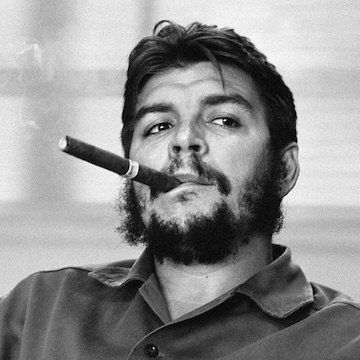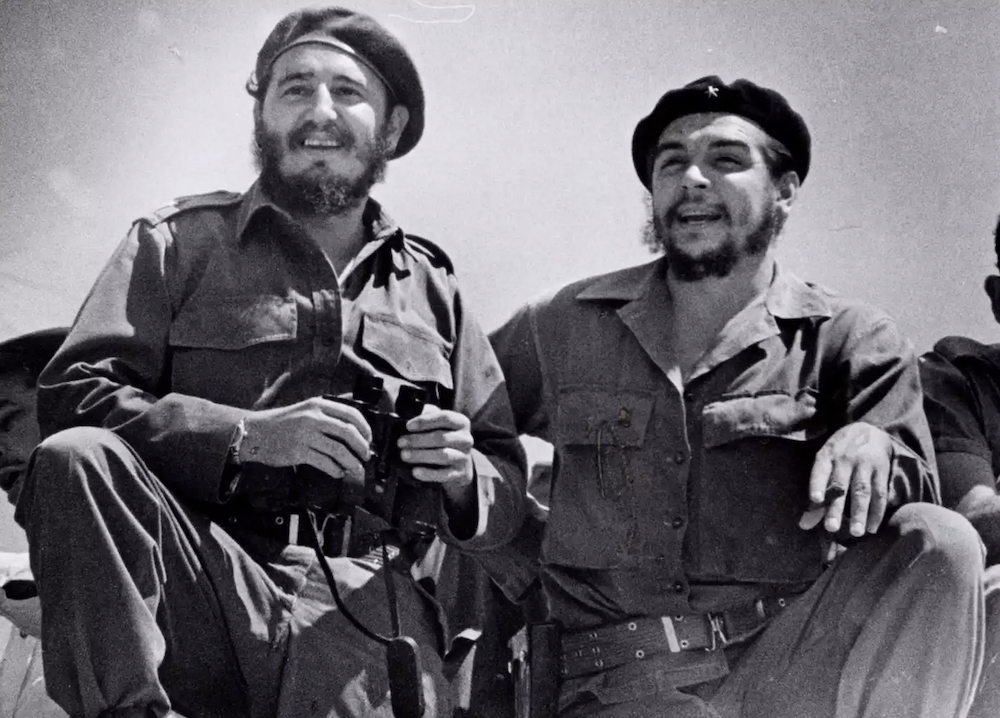Che Guevara Biography

The silhouette of Che Guevara is one of the most iconic images of the 20th century. His defiant posture is viewed as everything from an inspirational idol of revolution, to a retro and vintage logo. His life story is one that's filled with intrigue, drama and controversy. Some call this man a revolutionary. Others view him as a dangerous rebel that used his charisma for terror. Who was Che Guevara? This one man managed to live the life of a student, an intellectual, a rebel and a leader during his short time on the planet.
The Early Life of Che Guevara
The man who would become one of the most visible faces of the Cuban Revolution was born as Ernesto Guevara in June of 1928 in Rosario, Argentina. Guevara was the eldest of five children in an aristocratic family. His early political thoughts were shaped heavily by the conversations he overheard regarding the Spanish Civil War. In fact, Guevara's father regularly hosted veterans from the conflict at the family's home. Young Guevara showed signs of intellectual power early on through his enthusiasm for chess, poetry, mathematics, political science and archaeology. He was known to tear through the pages of his father's extensive library in search of intellectual insights from everyone from Nietzsche to Aristotle. The writings of Karl Marx would influence him in a profound way.
Che Guevara's Motorcycle Years
Guevara's appetite for learning eventually landed him in medical school at the University of Buenos Aires. However, his hunger to explore the world would soon lead him away from school to pursue a journey that has since become the subject of novels and movies. The explorations he took on as a young adult would also shape his philosophical and political ideals in ways that changed history. His first journey was a 2,800-mile trip through the rural provinces of northern Argentina that he took in 1950. He traveled using a bicycle with a small engine. He then enlisted his friend Alberto Granado to take a nine-month trip that spanned 5,000 miles through a large portion of South America. His journey took him through the Andes Mountains, the Atacama Desert, the Chuquicamata copper mines and the area surrounding Machu Picchu. The journey even brought the duo as far north as Miami, Florida. Guevara was struck by the poverty and unfairness he witnessed as he trekked through Latin America. He was particularly impacted when he encountered what he saw to be the persecution of communist people and the exploitative nature of capitalism. Che Guevara's motorcycle years ultimately inspired him to leave behind his study of medicine and enter the political arena.
If you tremble with indignation at every injustice, then you are a comrade of mine. - Quote by Che Guevara
Che Guevara Becomes Armed and Active
Che Guevara was not done traveling once the first two motorcycle journeys of his life were complete. He set out in July of 1953 to visit Bolivia, Peru, Ecuador, Panama, Costa Rica, Nicaragua, Honduras and El Salvador. His journey took him through land that was operated by the United Fruit Company at the time. It was during this period that Guevara finally got on the radars of his conservative relatives because of his affinity for Joseph Stalin and aggressive attitude towards capitalism. He traveled to Guatemala to take his first big steps as a revolutionary by supporting President Jacobo Árbenz Guzmán's efforts to redistribute land owned by the United Fruit Company to peasants. It was during this period that he linked up with both high-level officials in the Arbenz government and Cuban exiles. These connections would eventually introduce him to Fidel Castro. Guevara became an ally of President Arbenz's at a time when the United States government was actively trying to remove him from power using propaganda techniques and CIA involvement. Guevara briefly joined a militia organized by the Communist Youth before shifting his attention to medical duties. However, Arbenz submitted to defeat and allowed for a military junta that placed CIA-backed Castillo Armas in power. The defeat sealed Guevara's disdain for the United States, his devotion to Marxist principles and his support of the use of arms for a successful resistance. After marrying Hilda Gadea Acosta, Guevara arrived in Mexico City to spend time working in a hospital and giving lectures. This was also the period during which he finally met Fidel Castro in person for the first time. The two formed a friendship that would change the course of both Latin America's history and the international political atmosphere of the century ahead.
Che Guevara and the Cuban Revolution
Fidel Castro began his plan for revolution with an unsuccessful attack against Batista's army. Most of the men involved were killed or captured by the time the attack was over. Guevara managed to get away unscathed. He and a band of guerrilla fighters hid in the mountains while they planned their next move. Guevara made a point to engage with the poor subsistence farmers they encountered in the mountains by creating grenade factories, building bread ovens, establishing health clinics and setting up classrooms for reading and writing. Guevara was second in command to Castro by this point. American intelligence considered him to be Castro's brain in regards to strategy and vision. Guevara also often oversaw the execution of spies and deserters. He recognized and took advantage of the fact that media and the radio were powerful tools for broadcasting the rebel's cause. He founded Rebel Radio in February of 1958. The stakes were high at this point because the Cuban government was cracking down on the rebels by executing them on the spot if they were found or captured. However, the rebels persisted by launching a number of ambushes. The rebels were soon able to take over Santa Clara. President Fulgencio Batista had agreed by this point to flee to the Dominican Republic. A full takeover was finally complete when Castro and his followers stormed Havana to take control of the capital. More than 2,000 were dead after two years of revolutionary fighting.

Che Guevara's Vision Realized
Che Guevara was now free to develop plans for Cuba's political and economic future. Some of his first steps involved land reform laws. It was also during this time that he divorced his first wife. He married Aleida March shortly after. Guevara would have five children by the end of his life. The end of the revolution also brought with it a period of bloodshed as the new government dealt with its enemies from the conflict. It is estimated that as many as 100 people were executed by firing squads under Guevara's direct jurisdiction. He eventually took on the roles of both Finance Minister and President of the National Bank. His financial policies ultimately cut off Cuba's financial ties with most of the Western world. He reacted by trying to form what turned out to be less than ideal financial relationships with nations that were part of the Eastern Bloc. The Cuban economy was also plagued by absenteeism and low productivity. Many people credit Guevara with being the architect behind the Cuban and Soviet relationship that become such a large global force. However, the outcome of the Cuban Missile Crisis ultimately caused Guevara to denounce his Soviet allies.
I am not a liberator. Liberators do not exist. The people liberate themselves. - Quote by Che Guevara
The Congo and Bolivia
Che Guevara spent time traveling the world to speak at diplomatic events. He also offered his guerrilla experience and expertise to support the Marxist Simba movement during the conflict in the Congo. However, the cultural and political factors at hand made it impossible for him to export his revolutionary ideas to the fighters there. Guevara exited the Congo with six of his fellow Cuban survivors after enduring many battles and hardships. He then traveled to Bolivia to assist with a burgeoning guerrilla movement. However, his recruitment attempts were ultimately unsuccessful.
The End for Che Guevara
It is believed that the CIA was on the hunt for Guevara in Bolivia in 1967. Bolivian Special Forces also wanted him. It was an October day when 1,800 soldiers circled his encampment and battled it out. Guevara was injured before being captured. He was defiant and uncooperative as Bolivian officials attempted to interrogate him. Bolivian President René Barrientos ordered his execution the following day. This was done against the United States government's desire that he be transferred to Panama for additional interrogation. Che Guevara was paraded past Bolivian soldiers before being killed by a bullet to the chest at the age of 39.
We cannot be sure of having something to live for unless we are willing to die for it. - Quote by Che Guevara
The Legacy of Che Guevara
The handwritten diary and personal poems left behind by Che Guevara have given the world glimpses inside the mind of one of the most famous revolutionaries in history. Guevara remains a national hero in Cuba, where his image adorns the 3 peso banknote and school children begin each morning by pledging "We will be like Che." In stark contrast, Guevara remains a hated figure amongst many in the Cuban exile and Cuban-American community of the United States, who view him with animosity as "the butcher of La Cabaña". Despite this polarized status, a high-contrast monochrome graphic of Che's face became a universally merchandized and objectified image, found on an endless array of items, including T-shirts, hats, posters, tattoos, and bikinis, ironically contributing to the consumer culture Guevara despised. Yet, he still remains a transcendent figure both in specifically political contexts and as a wide-ranging popular icon of youthful rebellion.
